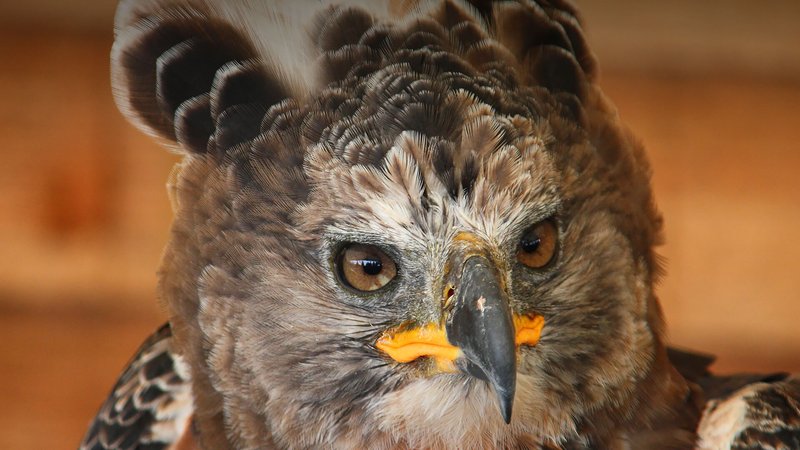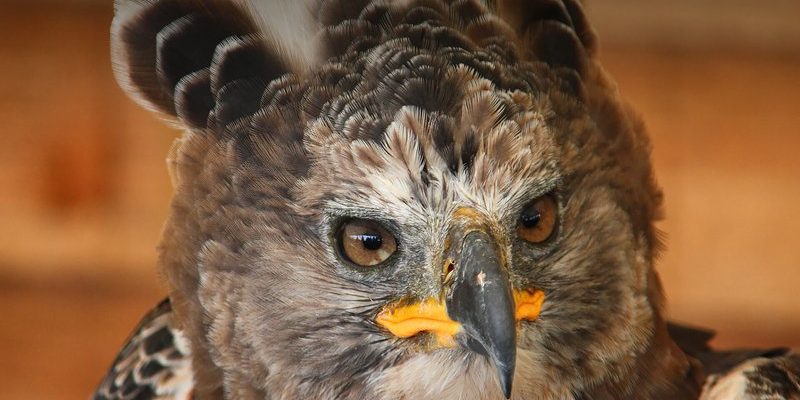
The crowned eagle, with its regal vibe, plays a crucial role in its habitat, much like a top chef in a bustling kitchen. If that chef were to leave, the entire kitchen could quickly turn chaotic. Similarly, the crowned eagle helps maintain the balance of its ecosystem by controlling populations of prey. Unfortunately, this bird is grappling with various threats that put its survival in jeopardy. Before we explore its current status, let’s get to know this fascinating species a bit better.
What Is The Crowned Eagle?
The crowned eagle, scientifically known as *Stephanoaetus coronatus*, is one of the most powerful eagles in Africa. Found mostly in the dense forests of Central and West Africa, this eagle has striking dark plumage, a distinctive white crown, and piercing yellow eyes that seem to see right through you. These features not only make it visually stunning but also help it blend into its arboreal surroundings, camouflaging it from potential threats.
This eagle isn’t just a pretty face; it’s also an exceptional hunter. Crowned eagles are known for their powerful talons and strong beaks, allowing them to catch and consume prey as large as small monkeys or duikers. Their hunting technique typically involves soaring high above canopy forests before swooping down with incredible speed to capture unsuspecting animals below. It’s a thrilling spectacle, full of grace and precision.
When you think about crowned eagles, you might picture a lone warrior in the skies, commanding their domain. These birds prefer solitary lives or form monogamous pairs during the breeding season. They build large nests high in the trees, where they raise their young, teaching them the ways of the wild. But despite their formidable presence, crowned eagles are facing serious threats that could change their survival story.
Current Conservation Status
So, what’s the conservation status of the crowned eagle? Currently, this majestic bird is classified as Near Threatened by the International Union for Conservation of Nature (IUCN). This means it’s not quite endangered yet, but it’s on a rocky path that could lead there if we don’t act. Let’s dig into what that means and what’s putting the crowned eagle at risk.
The primary reasons behind their precarious status include habitat loss, hunting, and conflict with humans. As forests are cleared for agriculture and urban development, the crowned eagle loses its homes and hunting grounds. Imagine moving to a new city, but all the best restaurants and parks are gone. Frustrating, right? That’s how these birds feel as their habitats vanish.
Hunting also poses a significant threat. In some regions, crowned eagles are hunted for their feathers or because they are mistakenly seen as pests. This human-wildlife conflict often arises from misunderstandings about the eagle’s ecological role. Many don’t realize that crowned eagles can actually help control rodent populations, contributing to a healthier environment.
Habitat Loss and Its Impact
One of the biggest threats to crowned eagles is habitat loss. Think about your favorite park or nature spot; if it were bulldozed for a new development, you’d feel a real sense of loss. That’s precisely what’s happening to the crowned eagle’s habitats due to deforestation and agriculture expansion.
Deforestation is often driven by logging, agricultural practices, and infrastructure development. Forests are cleared to make way for crops, which directly impacts the crowned eagle’s ability to find food and nesting sites. With fewer trees to perch on, these eagles struggle to maintain their territory and raise their young. The decline in suitable habitats impacts not only the crowned eagle but also countless other species. It’s a domino effect that can lead to ecological imbalance.
To get a better perspective, here’s a simple comparison: think of the crowned eagle as a vital piece in a vast puzzle. When you remove significant pieces, the image becomes distorted and incomplete. That’s the situation these eagles face as their habitats shrink.
Hunting and Human Conflict
Another considerable threat comes from hunting and human conflict. Imagine grabbing a snack and then finding out someone has mistaken you for a nuisance. That’s the reality for crowned eagles in some areas, where they are hunted or persecuted.
In certain cultures, the feathers of crowned eagles are considered valuable for traditional regalia or ceremonial purposes. This demand puts additional pressure on their populations. Also, some farmers view these eagles as threats to their livestock, mistakenly believing they might prey upon small domestic animals. This leads to unnecessary killings, which further endangers their numbers.
It’s essential to educate communities on the role of crowned eagles in maintaining ecological balance. When people understand that these birds actually help by controlling rodent populations, they might view them less as threats and more as allies in nature.
Conservation Efforts
Thankfully, there’s hope for the crowned eagle! Conservation efforts are in full swing to protect this magnificent bird and its habitat. Various organizations are working tirelessly to ensure these eagles have the chance to flourish.
Protected areas and reserves have been established in regions where crowned eagles reside. These areas limit human activities like logging and agriculture, helping to preserve vital habitats. Education campaigns are also crucial, aimed at informing local communities about the importance of crowned eagles and how they can coexist peacefully.
Here’s the thing—conservation isn’t just about saving one species. It’s about preserving entire ecosystems. When we protect the crowned eagle, we’re also ensuring the survival of countless other species sharing its habitat. It’s a team effort that benefits nature, humans, and the planet as a whole.
What You Can Do to Help
You might be wondering, “What can I do to help?” The good news is that everyone can play a part in conservation, even if you’re not living in Africa. Here are a few simple ways to make a difference:
- Support Conservation Organizations: Donating to organizations focused on wildlife conservation can have a huge impact.
- Spread Awareness: Talk about the crowned eagle and its struggles. The more people know, the more support conservation efforts can gain.
- Practice Eco-Friendly Habits: Reducing waste, promoting sustainable products, and supporting local wildlife can create positive ripples.
- Experience Nature: Visit wildlife reserves and support ecotourism that fosters appreciation for nature and wildlife.
Each of these actions, no matter how small, contributes to a more significant cause. When more people get involved, it’s like forming a powerful coalition for the crowned eagle and other wildlife.
Is the crowned eagle threatened or endangered? While it’s currently classified as Near Threatened, the challenges it faces are real and pressing. From habitat loss to human conflict, these beautiful birds are hanging on by a thread. But there’s hope through continued conservation efforts and public awareness.
As we continue to learn about and appreciate the crowned eagle, let’s strive to act as advocates for its survival. Every effort counts, and together, we can ensure that future generations get to marvel at this incredible bird as it soars gracefully through the skies. With awareness and action, we can be the change that helps protect the crowned eagle and our planet’s biodiversity.

